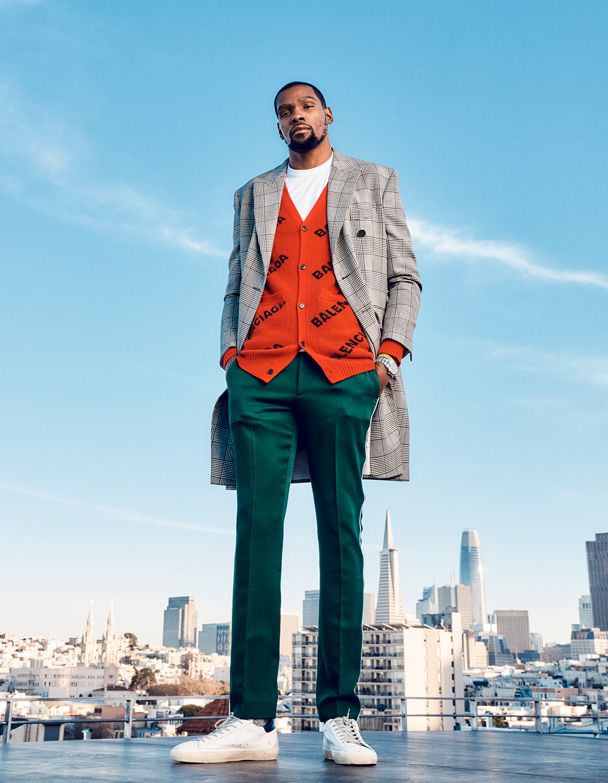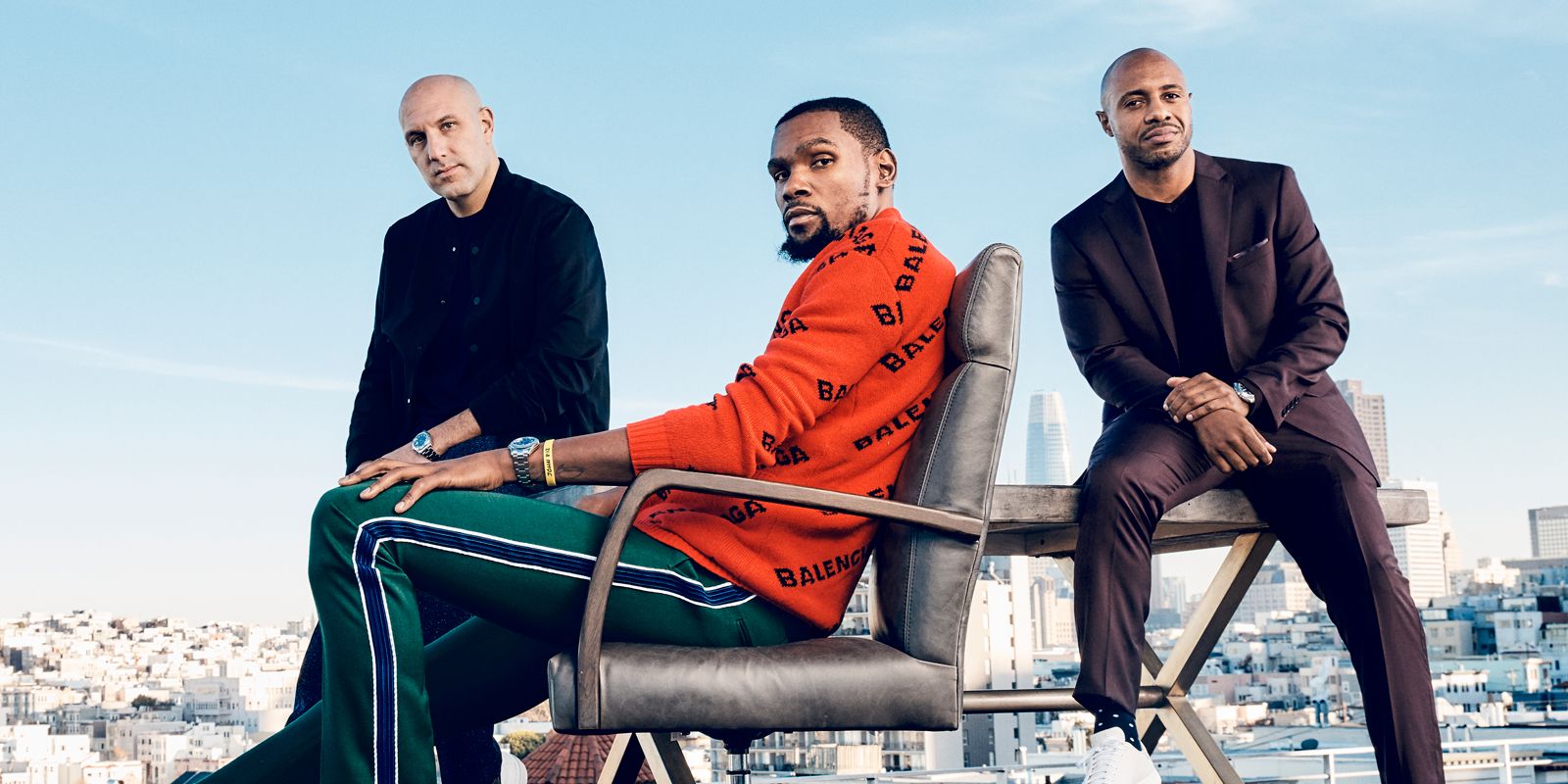The story of When Kevin Met Rich began at a Jay-Z concert back in 2008. Kleiman was representing the rapper Wale. Wale knew Durant because they both were from the DC area. Before the show, Jay-Z’s manager invited Durant backstage to meet HOV himself. In a moment of 19-year-old self-doubt, Durant balked. A bad case of impostor syndrome set in.
“I was just a rookie,” Durant says. “Who the f— am I to go in there? Like, I’ll probably walk in there and see Kobe or LeBron. I can’t be sitting in there, talking with them yet. I ain’t up there on that level.”
Kleiman loves telling this story. It’s still the essence of his relationship with Durant. He’s always begging Durant to talk more about the business and philanthropic ventures they’ve built together. Durant is always humbly stepping away from the spotlight. Because while Durant can impose his will on the basketball court, he’s still a bit reluctant to flex off of it.
“I know Rich wishes I’d do that more: stand up for what I’ve done,” Durant says. “But at the same time, I’m not trying to go overboard with it. We’re not looking to set the flag up and say, ‘Yo. This is Thirty Five Media all around the world. Make sure you pay attention to us!’
“
In this sense, Durant knows exactly who he is. He’s not a hustler or a hype man. He’s a hooper who needs people like Kleiman and Thirty Five Ventures marketing whiz Sarah Flynn to build his business and brand for him. The company has 10 employees at the moment, but it is moving into a new office building in New York City as it continues what Durant insists is a careful expansion. “I just feel like you can do it more of a strategic way,” he says. “If you put yourself out there too much and then underdeliver … that’s not good.”
Kleiman laughs. If Durant is more comfortable downplaying their accomplishments and ambitions, he’s fine with it.
“If I was left to my own devices, I turn into Flava Flav sometimes,” Kleiman jokes. “It doesn’t affect my job, my pay, my ownership, nothing, if people in Prince George’s County don’t fully understand the magnitude of what Kevin is doing [in opening the Durant Center]. However, it keeps me up at night — on behalf of him. That’s how much I want [recognition] for him.”
This reluctance to self-promote is part of the reason Durant was intrigued by the concept of the show. He knew he couldn’t be the only athlete who took time to find his footing in the business world or questioned whether he belonged in Jay-Z’s dressing room.
“I did not have the experience to be in that room,” Durant says of himself as a rookie. “Once I started to get experience, I had something to give back in those conversations. I was more comfortable.”
It took him almost a decade to get there, though. And even now, he finds himself asking more questions of the accomplished people he meets with than answering them.
“The cool part about KD on the show is you’re watching him learn with you,” Williams says. “Nobody is trying to say, ‘Hey we’re the leaders of the free world and we know everything there is to know.’ This is like an exploratory journey.”

“I don’t know what I could be doing” after his playing career ends, Durant says. “I just like what I’m setting up for myself now — something sustainable.” Shayan Asgharnia for ESPN
For Durant and Kleiman, Williams was the perfect choice to host the show. They felt that his own story of venturing into the business world — his professional playing career was ended by a motorcycle accident only a year in — gave him a unique perspective.
As the No. 2 pick of the 2002 NBA draft, he had the same kind of golden pathway laid out as Durant did as the No. 2 pick five years later. “I’m 18, 19 years old, and I’m sitting there watching Puff [Daddy] play the piano, [Scooter Braun] is pitching me on signing with Bad Boy, and I’m like, ‘How the hell is any of this happening?’
” he says.
“Back then nobody really saw how inefficient the model was. Your agent has 25, 30 other people and then they hire one marketing director who was just splitting his time.”
Then it all went away. His second career had to begin before his first one ever got off the ground. And he started asking the types of existential questions you can see only once your existence has been fundamentally altered.
“I just think that you have guys now that are driving the car, whereas before they would sit in the back and let ownership drive the car,” Williams says. “The currency has changed. Guys still do endorsement deals, but now it’s not about endorsements, it’s about, how do I own equity? How do I get a 10 multiple on what my investment is?”
In the past two decades, the best athletes have fundamentally changed the business of sports in much the same way Jay-Z and Diddy changed the music industry. Why let the record label own your songs — or your agents control your image — when you can produce, distribute and own them yourself?
It happened organically at first. Then the Warriors took it to a new level. Players such as Andre Iguodala and Stephen Curry started getting chummy with the venture capitalists and digerati who drove up from Silicon Valley to sit courtside at Warriors games. By the time the team went to the Hamptons to pitch Durant on joining as a free agent in 2016, the opportunity to immerse in the Bay Area’s vibrant business scene was a major selling point.
“It was like, ‘Listen, man, we’re a family. We’re gonna embrace your interests,'” Iguodala says of how the team talked to Durant. “‘I mean, you’re gonna turn it into business anyway. So we can help out in any way possible, and we got an ownership who feels the same way.'”
Joe Lacob, Warriors owner and venture capitalist, says he does whatever he can to create a culture that encourages personal growth and exploration.
“I was really good as an investor for 30 years. But I always knew that in my second life — I wanted to have a whole other business life, because it reinvigorates you,” Lacob explains. “And to me that was about sports. So I left completely from the VC industry and went to do this full time.
“While you’re in your primary career, I think you’re trying to prepare for your second career. And hopefully by the time your first career has reached a normal logical end point, then you’re ready to dive in and do it in a big way. That’s what happened for me. That’s what these guys should do too. They’re not gonna be experts in investing while they’re players, but they can be learning. And learning from meeting top people, learning from a few investments. So that by the time they’re done, hopefully they’re ready to take the next step, make that into a second life.”
Ask Durant what he wants to be doing in his second life, after his playing career ends, and he sounds a bit like Phil Jackson. “I could be off in Montana on a ranch over by the water. Or living on the slopes. I don’t know what I could be doing. I just like what I’m setting up for myself now — something sustainable.”
At 30 years old, he has a lot more basketball to play, and huge decisions about where he’ll spend the rest of his career still to make. For now, he’s focused on building a legacy on and off the court, starting with a $10 million investment in the learning center that bears his name.
But before he gets to that center’s opening ceremony, he needs to make a stop. It’s nearly 4 p.m., and he hasn’t had time for lunch. So as Durant and his team head from the Warriors’ swanky team hotel in Georgetown to Prince George’s County, his caravan of SUVs pulls over at a convenience store for a croissant and some candy. No matter how far Durant travels in life, the sweet tooth comes with him. As a kid growing up on these streets, Durant would often stop at the McDonald’s where his brother worked and fill up his water cup with Sprite.
On this day, he’s telling that story to the first group of children who will be supported by the Durant Center.
“I told them that this building has my name on it, but it’s yours,” Durant says. “You’re going to spend more time here than I will. Make it your home.”
Durant had been wanting to expand his charitable giving in the same way he’d expanded his business portfolio. Real money — in this case, a full third of his current yearly salary of $30 million — that would actually make a difference to kids who were walking the same path he once walked. In 2018 alone, he donated a total of $3 million to the basketball and sports leadership programs at the University of Texas and committed this $10 million (over 10 years) to the Durant Center.
“That’s doing something,” he says. “We make a lot of money, so we should be able to give it back.”
Just a handful of media entities were invited to the opening of the learning center, and he sent all of them away when he met privately with a small group of the 59 students in the inaugural class, who will participate in after-school tutoring, summer programs and personal development workshops throughout high school and even college.
“I can remember being a high schooler here, living next door,” Durant says. “I was the No. 2 player in the country, and me and my mom were living in a two-bedroom right next door to here. You’re waking up in the struggle still.”
He looks around the gym at Suitland High, where he attended ninth grade. It is packed with people who knew him then, or like to claim they did. A group of high schoolers follows him everywhere, hoping for advice — or maybe just a selfie.
Durant seems genuinely moved.
“That’s what life is about,” he says.
He seems to be making an effort to connect with each person reaching out, even if it’s just a quick interaction. It wasn’t so long ago that he was too afraid to approach Jay-Z in his dressing room, too shy to ask for advice — or maybe just a selfie. Sometimes the barriers to entry are self-made. If he can help others find their confidence, that feels important.
It is both dizzying and inspiring — the culmination of 30 years of work and self-discovery but also a first attempt at shaping a legacy.
“We all like different things,” he says. “We’re all going to do different things. But something’s going to bring us together. Maybe it’s here.”
This story appears in ESPN The Magazine’s March issue. Subscribe today!
